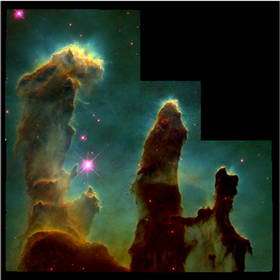Evidence builds for supernova's role in solar system creation

Clear evidence in a Chinese meteorite for the past presence of chlorine-36, a short-lived radioactive isotope, lends further support to the controversial concept that a nearby supernova blast was involved in the formation of our solar system, according to a report forthcoming in the February 1 issue and published online Jan. 24, of the Proceedings of the National Academy of Sciences.
Image: The Eagle Nebula, as photographed by the Hubble Space Telescope. This famous photo, often known as "The Pillars of Creation," shows giant nebular clouds being evaporated by the ferocious energy of massive stars, exposing emerging solar systems, much like our own. Credit: NASA/HST/Jeff Hester and Paul Scowen
Known as the Ningqiang carbonaceous chondrite, the primitive meteorite is a space relic that formed shortly after the solar system’s creation. It contains pockets of still older materials or “inclusions” that contain that contain calcium, aluminum and sodalite, a chlorine-rich mineral.
A Chinese-American team of scientists including Yangting Lin, Ziyuan Ouyang and Daode Wang from the Chinese Academy of Sciences, and Yunbin Guan and Laurie Leshin from Arizona State University found the rare isotope sulfur-36 in association with the sodalite. Though it can be formed in various ways, sulfur-36 is a natural decay product of chlorine-36. Its association with the chlorine in the sodalite is strong evidence for the past presence of chlorine-36, which has a half-life of only 300,000 years, in the early solar system.
The solar system’s chlorine-36 could have formed in two different ways – either in the explosion of a supernova or in the irradiation of a nebular cloud near the forming Sun. The irradiation explanation is unlikely in this case, however, since the mineral the chlorine-36 was discovered in must have formed a significant distance from the sun.
“There is no ancient live chlorine-36 in the solar system now,” said Leshin, who is director of ASU’s Center for Meteorite Studies. “But this is direct evidence that it was here in the early solar system.
“We have now discovered the first solid evidence for two different short-lived radionuclides in the GeoSIMS Lab at ASU – iron-60 and chlorine-36 – and both of them provide evidence for where the solar system’s short-lived radionuclides came from. It’s producing a really strong argument that these radionuclides were produced in a supernova that exploded near the forming solar system and seeded the solar system with these isotopes.”
In a “Perspectives” article in the journal Science last spring, Leshin and others argued that the presence of iron-60 was evidence that the solar system formed as a result of violent star-creation processes in a dense nebula rife with short-lived, high-mass stars and supernovas – a very different creation story than the traditional view that the solar system formed from a slowly condensing molecular cloud.
Leshin points out that the current paper is part of a growing collaboration between space sciences at ASU and the Chinese science community, in this case being driven by Guan, a native of China , and manager of the ASU GeoSIMS Lab.
“Lin, the first author on this paper, was a visiting fellow in our lab for six months. We’ve published several papers on meteorites with groups in China – it’s a very fruitful relationship,” she said.
Source: Arizona State University

















